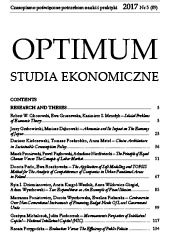Zróżnicowania regionalne w Unii Europejskiej. Weryfikacja hipotezy Williamsona
Regional disparities in European Union: the Williamson hypothesis
Author(s): Jarosław Michał NazarczukSubject(s): National Economy, Supranational / Global Economy
Published by: Wydawnictwo Uniwersytetu w Białymstoku
Keywords: regional disparities; Williamson curve; Williamson hypothesis; EU
Summary/Abstract: The aim of the paper is to verify the Williamson hypothesis that assumes a nonlinear relation between GDP per capita of national economies and the level of regional disparities, which take a form of an inverted U-shaped curve. In order to test the hypothesis, panel models were used to analyse data for 22 out of 28 EU members. To calculate the level of regional inequalities, the author uses an indicator proposed by Szörfi [2007], which is a standard deviation between GDP per capita in a region compared to the entire country, divided by the GDP per capita of the national economy. The conducted analysis of the period of 1995-2011 has confirmed an initial increase in regional disparities accompanying the growth of national income level (in PPS per capita), which after reaching a certain level of GDP per capita (about 26,400 PPS) tends to decrease along with the further increase in income levels. The two tested specifications of the models (quadratic and logarithmic) mostly indicated the upward side of the curve, showing increasing disparities. Their predicted values diverged significantly for income levels, starting from ca. 30,000 PPS per capita. However, the quadratic specification of the model was better fitted to the data. The findings from the conducted analysis for Poland and other EU countries indicate the important issue of regional diversity, so closely related to the national level of economic development. Therefore, the attempts of many EU countries to significantly reduce regional disparities are unsuccessful. Afiliacja: Wydział Nauk Ekonomicznych, Uniwersytet Warmińsko-Mazurski w Olsztynie
Journal: Optimum. Economic Studies
- Issue Year: 76/2015
- Issue No: 4
- Page Range: 43-53
- Page Count: 11
- Language: Polish

